#Compact controller dimensions
Explore tagged Tumblr posts
Text
Multiverse part 3
You sat in a small room on a padded chair, with equipment set up around your arm, chest, and fingertips. A polygraph test. That's what you were being forced to take. And to your chagrin, Ghost is in the room with you and Captain Price.
"Try to relax, yeah?" Price commented. He must've noticed your restless leg.
"I'll do that, shall I? I've done nothing wrong, other than exist and I'm being interrogated. Because that's what this is— an interrogation." You finally turn your attention from Ghost to look at Price, who's sitting at the desk by your side. "Tell me, Captain. Did you get this same treatment when you came back after spending all that time locked up in the gulag?"
His dark eyebrows furrow in confusion. A sigh escapes your bitten lips. That's only in your...world, for lack of a better term. Dimension? Universe?
"I haven't been to the gulag here." Yeah, obviously.
With an impatient wave of the hand that doesn't have cables strapped to it, you mutter, "Let's get on with this circus act, then. Ask your questions."
Ghost steps forward, his arms unfolding as if he's about to speak to you, but Price swiftly intervenes, halting him with a raised hand.
"Alright then. Baseline questions first. Name." Ghost gives away nothing when you say your last name is Riley.
It goes like this for a few, then he switches to the control questions, until finally moving on to the relevant ones.
"How did you get here?" I don't know.
"Do you know why you're here?" No.
He pulls up a photograph. "Recognize him?" Captain MacTavish.
Another photo. "Him?" I don't know.
"What do you mean by that?" If that's Roach, I've never seen his face unmasked.
"You're sure you don't know him?" Unless that man's name is Gary Sanderson, no. I do not know him.
Price acknowledges your response with a nod, then shifts his gaze towards Ghost, whose head slightly tilts forward. Returning his attention to you, he retrieves a final photograph. "What about him?"
As you look at the picture, your eyes begin to well with tears, lip trembling violently. A new fracture reverberated through your tender heart, intensifying the ache in your chest. Yes.
"Who is he?" Price softly asks.
"That's my Simon," your voice broke on the last syllable. It was hard to not use a possessive adjective when the face of your husband was in that picture.
Blinking the tears away, you clear your throat. "Anything else, Captain?"
Price purses his lips under his hefty facial hair and responds, "Just a few more questions."

Once finished, you sat unabashedly staring at Ghost in the tiny room. "I wear Roach's tags alongside yours, in honor. He was with you until the very end, and for that, I couldn't be more grateful."
Ghost is completely silent, but you continue talking anyway. "I've been married to you since a bit after you came home on leave that one time. You know the one."
His eyes are emotionless, blank, as he stares at you. But you know him like the back of your hand. You've got his full attention.
"I accompanied you to your brother's wedding. He married a woman, Beth. She was good for him. They had a baby, your nephew, named Joseph. The love you had for him was one of a kind. I had told you later that evening that I dreamed of the day you'd look at our children like that."
With a shuddery breath, you tell him how none of those matters. Because your husband is dead, and you're stuck here. With his counterpart that hates you.
With a hushed click, the door closes shut behind him as he leaves, yet its resounding noise fills the compact room you're in.
You begin to fidget with the sizeable ring that hangs on a thin necklace beneath your shirt— the metal is warm under your touch as if it had never gone cold in the first place.
As if Simon had never taken it off his finger to go find Makarov.
ah theyre short but hurt. much pain.
taglist: @1mawh0re @sae1kie @darkravenqueen98 @chinuneko @thestartitaness @bowtruckleninja @hawsx3 @uyudunmuyavru @prettyoatmeal @arael-asuka @spencerreidisbae123 @beau-min @lovefks @maliakealoha @kit-williams @clear-your-mind-and-dream @theloneshadow24 @wolfieisacat @littlebunie @bloobewy @kkaaaagt @sadsackssss @hypernovaxx @halobaby @lildemon475 @animarix @just-pure-trash @catatemyslideshow @hayleybarnesx @sasagehoes @thigh-o-saur @youdontknowe @destroyer-of-za-warudo @maxisqq @k4marina @onlineoutcast
#call of duty#simon ghost riley#simon riley x reader#multiverse cod#09 ghost#22 ghost#cod mw2#cod mwii#cod#simon ghost riley x reader#simon riley x you#simon riley#simon ghost riley x you
2K notes
·
View notes
Text
The worldbuilding of svtfoe is a very interesting hot mess to think about. It's like a defective puzzle: the pieces don't fit together quite right.
Especially in regards to magic/the issue of destroying it in the finale. You basically have to forget everything that was established about magic before Cleaved for it to actually feel like a sensible writing decision.
How do I know this? Because, for mad reasons, I decided to go through the series and catalog as many instances of magic being implied subtly or explicitly that it was a thing beyond Mewni. All examples are below the read more and sourced by their respective episodes
Dimensional scissors being owned by multiple beings from different dimensions, vast majority of them appear non-human/non-mewman (Shown since beginning of series)
Ponyhead uses magic to blast crystal stalactites on the ceiling of the Amethyst Arcade, making them crash into the guards from St. Olga's (S1E2: Party with a Pony)*
Star explaining how her wand needs to be regularly charged is worded in such a way that there are more like it in the multiverse (S1E8: Quest Buy You have to recharge wands with magical energy. If it goes to skull, it'll be dead forever!")
Quest Buy, an interdimensional retail store, sells wand chargers. If no other dimension has a wand like "Mewni", then there would be no reason for them to be sold (S1E8: Quest Buy)
The shard mines of Pixtopia are stated by the mine's taskmaster that they block magic. Considering that this dimension is the source of the magic mirror compacts/magic smart phones that are enable calls to anyone from any dimension, the wording implying magic period instead of a specific "butterfly magic" is interesting (S1E12: Pixtopia)
Tom's abilities in this episode (floating, fire control) seem to be a demonic variant of magic. While Daron Nefcy did say in the post-finale AMA that Tom could still create portals even after the destruction of magic (despite that same ability also being effected by Hekapoo shutting down the portal network), this fact was never stated in the show itself nor the spin-off books (S1E15: Blood Moon Ball)
Father Time, a plausibly magical being (this was never elaborated on in show nor in either spin-off books and the only answer came from Adam McArthur not Nefcy nor any of the show's writers) states that magic won't work on the wheel of time. Again, it is worded as magic period not "butterfly magic" or "royal magic" (S1E17: Freeze Day)
One of the "foolproof security measures" St. Olgas' is "no magic", with one of popups mentioning "magic sensors placed every 25 feet to ensure magic-free environment". If the school has such measures, then magic-using students must be a regular enough occurence to jutify it (S1E19: St. Olga's Reform School for Wayward Princesses)
Glossaryck's analogy on 'dipping down" is worded as follows: " Imagine the universe as this big old cauldron, and magic is the bubbly stew inside, and your wand is the spoon---Now the wand can only skim the surface of the hobo gravy, watery and brown. But if you want to get to the chunks, you've got to dip down. " Again, a singular magic, no differention for "butterfly magic" or "royal magic" (S2E1: My New Wand!)
Willoughby knows enough about magic to try and steal Star's wand to give herself a break (S2E6: Fetch)
Ponyhead uses magic to destroy Roy's shirt cannon. Roy also draws a magic circle on the ground that teleports Star, Marco, Ponyhead and Kelly to a temple where he then gives them the goblin dogs (S2E13: Goblin Dogs)
Etheria Butterfly, Moon's Aunt/Star's Great Aunt, pulls two Johansons underground via vines sprouted from magic seeds (S2E15: Games of Flags)
Rasticore is the sole person in the series to use a magical item that is not a pair of dimensional scissors to travel**. The Quest Buy gift card takes on a humanoid electric form to complete its expiration mode (S2E18: Gift of the Card)
Locked chains magically appear on the carriage door to keep Marco from leaving. Tom also uses his powers to resurrect Mackie Hand. (S2E19 Friendenemies)
Ponyhead uses magic to press the gas pedal on the car she's driving and later to repair the car (S2E24: Pizza Thing)
Magic (again, worded as magic period) is prohibited in the Bureaucracy of Magic building, complete with magic detector to find any "articles of magic, sorcery or occult objects of a mystical nature". The fritz is stated to be the result of "something somewhere sapping the power of magic from the universe". Once more, worded as a singular magic (S2E25: Page Turner)
The Naysaya is described as a demon curse. Whether curses are a separate thing from spells is never elaborated on in show or in the spinoff books (S2E26: Naysaya)
Preston Change-O, a being that sucked the joy out of Sensei's party guests. (S2E29: Trickstar)
Zedlord and Astrobell, who were crystallized by Rhombulus for destroying a planet and creating a black hole respectively. Considering that Rhombulus referred to his prisondres as "these guys" and the general design scheme of the non Earth/Mewni background characters, they are plausible inhabitants from other dimensions, not 'monsters" (S2E34: Crystal Clear)
The fritz is again stated to cause all magic (again no differention between types of magic) to weaken and fade (S3E1: Return to Mewni)
The Demoncism, with even features what Tom calls "magic manacles" (S3E12: Demoncism)
Marco suggests stopping Star's night portaling with magic glue. (S3E18: Sweet Dreams)
One of the supplies Janna brings to keep track of Star while she's night portaling is a "magic wave scope" (S3E23: Deep Dive)
Tom uses demonic magic to attempt to encase Mina in a coffin covered in sigils and golden magic chains (S3E24: Monster Bash)
Ponyhead once uses magic, in this case charging up a magic blast in preparation for facing Meteora, Gemini and Rasticore (S3E33: Skooled!)
The pillars/reverse waterfalls of magic found throughout the Realm of Magic are revealed to lead to other dimensions in the multiverse. Given the multiple pillars seen, it's likely that at least a good number of the connected dimensions use magic (S3E38: Conquer)
Marco's sword is revealed to be what kept a fire demon that once terrorized the Neverzonians sealed within a statue (S4E05: Ransomgram)
Wrathmelior has a emotional weather system that can cause severe storms if her emotions are in turmoil, possibly another form of demonic magic (S4E06: Lake House Fever)
The Quest Buy stock room is, as explained by the sloth employee, "a magical room that turns all your needless desires into pointless realities" (S4E11: Out of Business)
The Severing Stone is explicitly reffered to as an "enchanted rock" that posseses an edge so sharp that it can sever anything. The Blood Moon bal (S4E13: Curse of the Blood Moon)
In the beginning of the episode, we see Ludo attempt to steal Princess Quasar's magic bell, a possible counterpart to Star and her wand, complete with a counterpart to Glossryack (S4E14: Princess Quasar Caterpillar and the Magic Bell)
At Glossaryck and Meteora's first stop in the past, it is shown that a sea of magic was already present long before the Magic Sanctuary was built (S4E17: Meteora's Lesson)
Grobb/Neverzone Meteora explains that the old women of the mountain that found her and Bork/Neverzone Mariposa as babies taught her all of their spells. There is also Wyscan the Granter, a being that will grant requests in exchange for magic he can eat (S4E28: Gone Baby Gone)
According to Hekapoo, most of the patrons of the Tavern at the End of the Multiverse left their dimensions to "get away from magical issues or power-hungry rulers". Given the lack of elaboration on what exactly those magical issues were and how Star's rant focuses squarely on her family's misuse of it, this one might have been a last minute justification by the show to have Star destroying magic feel more natural. Whether or not it worked is up to debate (S4E36: The Tavern at the End of the Multiverse)
*I am aware of the whole "Ponyheads' powers are 'natural abilities' not magic" thing but A: the statement came from a tweet by a voice actor for the show (Adam McArthur), not Nefcy nor any of the show's writers so its canoncity is pretty weak and B: something as important as this should have been discussed in either hte show or one of the spin-off books. And, considering how Here to Help (which was 4 episodes before Cleaved) had Star somehow be able to gather a group of people from different parts of Mewni (Rick Pigeon, Ponyhead and Seahorse) and different dimensions (Kelly and Jorby, Talon and Quirky Guy) despite Hekapoo having shut down the mirror and portal network, it's possible that Ponyhead being magic was just forgotten
**It is mentioned in Star and Marco's Guide to Mastering Every Dimension that Rasticore is wanted for "unlawful alteration of regiestered, protected magic items (dimensional scissors)". This implies that his chainsaw was created from a pair of dimensional scissors but this is one of a multiple tidbits from the book that never comes up in the show itself
#svtfoe#star vs the forces of evil#this is why it's important to keep track of what you establish in your stories#If you don't you could accidentally break your own show's rules and destroy any suspension of disbelief the viewers' may have#other stuff
33 notes
·
View notes
Text
"You've earned no favors yet." -NLH
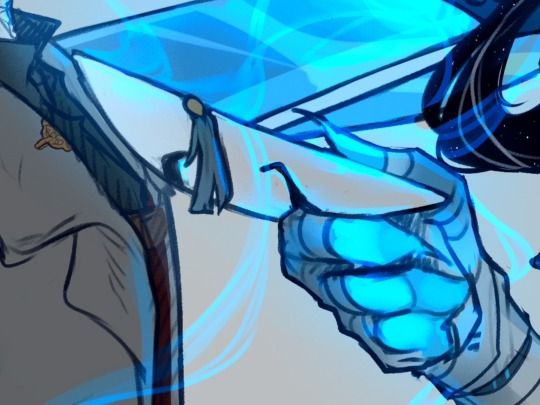


Ability structure/ anatomy:
-Abilities are made of energy. Both in Earth's dimension and in their own, the only difference being that their own dimension is adapted to their construction. That is to say, their state of existence is handled differently in each dimension.
On Earth:
-Abilities display their physical forms using Earth's atmosphere, light and gravity. They automatically adapt their own sense of gravity to the space they exist in, as they are not entirely physical on Earth.
They are physical enough for humans to come in direct contact with but not enough to be damaged.
As their forms on Earth are seen as variables, they have control over dematerializing and rematerializing at will from their human host.
Control and regulate the speed of their descent from a high jump. Which they can preform through temporary detachment from our gravity, as it does not bind their form energy.
-Abilities are bioluminescent. The level of energy / power coursing through them radiates to the exterior through glowing limb extremities most of the time.
Abilities can be damaged on Earth. Though only the physical form. As soon as the physical form sustains too much damage, the ability retreats to its current host and is on stand by from anywhere between hours and up to a month and more as they take the time to regenerate. Seeing as their physical form represents the extra energy the host body couldn't comprehend, the energy doesn't return inside the body, but it compacts itself and materializes into a small gem. (Much like we've seen in Dead Apple but they won't all be red).
-Nix🌙
#nixnephili#bungou stray dogs#bsd season 4#bsd fanart#bsd headcanons#decay of angels#bungou stray dogs fanart#mafia dazai#dazai bsd#bsd dazai#bungou stray dogs dazai#dazai osamu#osamu angst#no longer human#bsd abilities#ability#bungou stray dogs anime#bungou stray dogs art#fyo!atsushi au
561 notes
·
View notes
Text
people say that batman doesn't have any powers. NOT TRUE. his real power is pocket dimensions. he can't control them. the utility belt is actually just full of pictures of his children, and every time he reaches into the pockets he's actually just trying to pull out a situationally relevant picture of one of his kids but instead some gadget comes out. he doesn't know how this is happening.
last weeks villain was monologuing about cows and he tried to pull out a picture of Damian with his cow to show everyone because it reminded him of his kid, but instead a compact laser came out. which was useful to escape the ropes tying him up, sure. but he was just trying to brag about his baby
43 notes
·
View notes
Text
Alrighty! New itfts’s out time for me to theorize like alil idiot.
_________________________________ ’
Right now I'm starting to notice a pattern, especially for clocks character. From what I can see he's becoming more aware, more sentient, he's not a strange host like creature (ei. Algebraliens.))

And from what I can see, a small snippet of an alternate clock (who I will be addressing as obj c, for the sake of simplicity) setting up some popcorn, maybe sitting down at his couch, to watch a movie? To lounge about? To flip some channels.. and doze off, you know, avarage Sunday evening.

And at the end, as pointed out by user kyndal47 in the comment section of this episode, they point out the fact in the end we can see an image of clock, staring directly back at US, (that's if we bring up the brightness at 11:31, if you wanna see for yourself?)
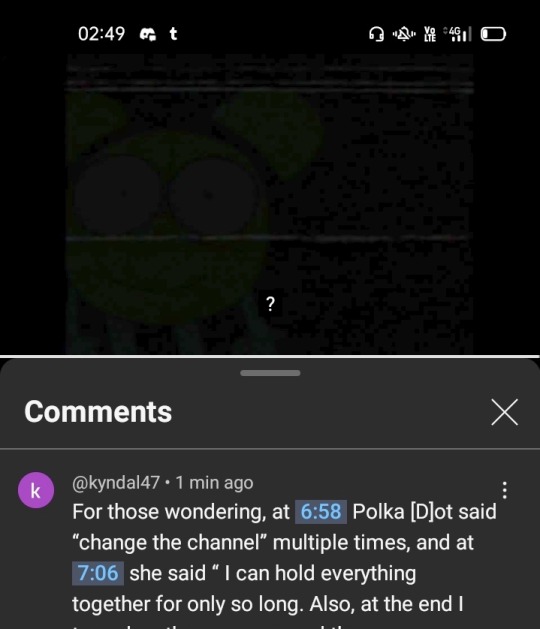
My first theory is about clock, more specifically, obj c, we see at the end he's setting up some popcorn to lounge, and from what I can observe. During the elimination, we see green turn into a radio as he gets eliminated. If your alittle observer like me!
(Im lying, I literally had to turn on the captions on my second watch because my silly ass forgot too :b!)
You'd notice greens still saying something.

“- There IS no coming back”

“Well, just to philosophize Between two eternities, I realize”

“it’s just a dream,-”

“- and my advice”
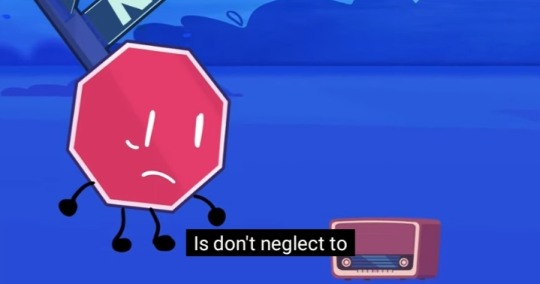
“Is don't neglect to”

“have a nice-”
And it cuts off. Just like that.
“it’s just a dream” r. Green says, “ and my advice is don't neglect to have a nice.., it cuts off, I don't know about you but if I had to assume, I'd like to think the ending to that sentence would've been, have a nice dream.
Have a nice dream? Obj c is dreaming, dreaming of himself being “clock” being a strange host - like creature, and more evidence to support this theory!
We hear our blurred out polka say (in reverse, again thank you user kyndal47 for providing this info) she says “change the channel” multiple times, and followed after by “i can hold Everything together for only so long”.
So from what I can see this is a dreaming obj c, subconsciously flipping through channels, while dreamin’! And perhaps polkas in a sense, a key to those channels, as her “dots” are portals that lead to different dimensions! (aka, channels!)
The blurred out polka is almost a glitched/ altered version of polka that's also more aware? Awake in a sense, she's a small and compact card with dots and her dots are portals to different channels, different channels SHE keeps together (by holding Herself together!) Literally! But when we see her fly out of blurry dot she seems less aware? Almost like she forgot what she said.
Its like when she was brought back again, she forgot a part of who she was, I mean heck! The polka we see in show barely even knows where her portals lead too!
Maybe she's in a sense a direct reflection of the tv were possibly watching the show through? The box that holds everything together, the card with millions of channels complied into one, the channels being represented as “portals” she can let people go through.
And the fact what were watchings a strange midnight amalgamation of a dream where our barely conscious obj c sleepily flips through channels while still stuck in a dream? And yet he still neglects to have a sense of control or logic in what happens in it, he forgets what or why he's here for.
He neglected what it meant to have a nice dream.
(tl , dr)
Clock, (the sentient one we see at the end of itft is addressed as obj c) may or may not be in a dream and polka dot is the key to the channels (aka universes) as her dots are portals that teleport to different places, she's stated in the episode “i can hold everything together for only so long” as supporting the theory she may be a direct reflection of the tv we're watching itft through, and pretty much the entirety of itft is a dream that obj c is stuck in.
#osc#object shows#its time for the#itft#itft clock#itft polka dot#itft green#its time for the theory!#quartzii thoughts#quartzii theories#theories#this is just some speculating! so dont take what i say to seriously. i love word vomiting on tumblr sometimes ^_^
90 notes
·
View notes
Text
Frying his backups (part 3)
(part 1) (part 2)
Okay. After plenty of thought I think I can take a guess on how:
(a) the thin cables and (b) the chair and (c) the thick cables
in Rick Prime's control room work (provided the theories that Rick Prime had been puppeteering other Ricks are true).

1. I debated with myself for a long while whether Rick Prime sat himself on the chair or made his puppets sit there, one by one, each time they needed maintenance, while he stood over them (the back looks like it could recline; the feet? not so much).
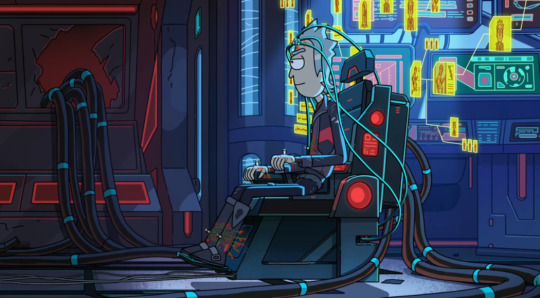
However, considering the chair looks like a throne, I'm leaning towards Rick Prime being the one sitting on the chair under "normal" circumstances ("normal" being when you're an evil jerk puppeteering hundreds of other versions of yourself for the lulz).
2. The thin cables protruding out of the chair are indeed part of the puppeteering throne. The question is:
(a) whether they were indeed designed to go to Prime's forehead, or (b) whether they were intended to directly connect to the brain implants of the Rick Puppets


like so:

(pardon the lousy art lol)
If the thin cables were intended to directly connect to the brain implants of the Rick Puppets (option b) then this means the throne was only used for maintenance, updates and inspection. Prime's brain implant was wirelessly connected to the throne, the throne basically being an intermediate equipment connecting Prime with his puppets during software maintenance. (He could also, like, stand and walk around his puppets to inspect them while holding the tablet. The very long cables of the tablet point to this). Prime did not need the throne for the actual puppeteering though, only for maintenance, which does sound more versatile. However, I don't really dig the mental image of five Ricks looming over Rick Prime, and I think he wouldn't dig it either :P He'd want them to be beneath him literally as well as figuratively. In addition, it's weird that there'd be equipment for casual puppet inspection inside the control room of his superweapon. You'd think he'd have a dedicated room for the whole puppeteering thing, with medical equipment, stuff for brain surgery etc.
So I'm leaning towards option (a): the thin cables were intended to go to Prime's forehead, similarly to how Eyepatch Morty placed them (only without an intermediary fingergun, of course). In this scenario, Prime was able to puppeteer "only" five Puppet Ricks at once max, one for each thin cable (or maybe even more, if each cable can carry the data for several Ricks). The throne contains the transmitter, or a transmitter amplifier of sorts, effectively functioning similarly to Evil Morty's eyepatch being the intermediate equipment. (On a different matter: five puppets at once is extremely impressive. Eyepatch Morty had to pause what he was doing in order to shoot Security Guard Rick through Evil Rick.) I'd bet that Rick Prime's brain implant is normally able to puppeteer other Ricks wirelessly, without the need of the throne nor cables to his own forehead, but the Rick Puppets being in different dimensions (in contrast to Eyepatch Morty being in the same place as Evil Rick) means he has to take some extra steps to make sure the signal reaches the other dimensions. And these extra steps involve the Omega Device. And suddenly there is a very good reason that the throne is placed in the Omega Device control room: it uses the weapon's connections to the infinite dimensions to reach the Rick Puppets scattered across the multiverse. The thick, apparently compact base of the throne probably connects the puppeteering equipment to the Omega Device's control panel. And there is an extremely good (practical) reason that Prime chose the intermediary equipment to be shaped like a chair: it was so he could be seated, comfortable and relaxed, without in danger of keeling over if his concentration wavered at any moment, and puppeteer his victims. It's also possible he used time crystals to freeze or slow time, permitting him to drastically increase the number of Ricks puppeteered live at any given time. In this scenario I would bet that the Omega Device is an evolution of the puppeteering tech: Rick Prime would want to send his puppets in various dimensions, and he'd need a way to stay connected to them wherever they were at all times, therefore he'd need some sort of tech that keeps track of the infinite dimensions... Hey, while he's there, why not improve the design to allow for the simultaneous murder of someone across the as-of-now-constantly-tracked infinite dimensions? (and with the possibility of this development, I'm suddenly very skeptical about what kind of improvements Eyepatch Morty has in mind. Maybe he could use the connection to the infinite universes to uuuuh simultaneously teleport all victims to a specific location, or to simultaneously add an implant to all victims or something)
3. Rick Prime would use his tablet, which is directly connected to the chair, to swiftly choose which Rick Puppets he is currently connected to. The pretty significant length of the tablet cables and the thin puppeteering cables meant he could probably stand up and walk around if needed, e.g. to the control panel.
(Or, if scenario (b) is true, the tablet was supposed to be used as demonstrated by Eyepatch Morty: to oversee his puppets, update the software, check for malfunctions, etc. Both tablet and Rick Puppets would be directly connected to the throne, so it checks out)

It's possible both scenarios (a) and (b) are true or partly true; if, for example, there was relevant medical equipment embedded in the floor, revealed at the press of a button (there is plenty of empty space in front of the throne...) then it's possible all operations could be carried out fully and autonomously inside the Omega Device facilities.
4. The thick cables were not originally part of Prime's chair; they were part of the machinery embedded in the wall instead. They were part of the Omega Device, linking the control panel to the infinite dimensions. Eyepatch Morty puppeteered Rick Prime (lol) to get them out.
So the order was something like this:
Scenario (a) the throne was used for interdimensional puppeteering: Rick Prime (brain implant) > five thin puppeteering cables > Puppeteering throne > five Rick Puppets (wireless receiver in brain implant) alternating swiftly by manual use of the tablet
Scenario (b) the throne was used for direct maintenance: Rick Prime (via tablet) > Puppeteering throne > five thin puppeteering cables > five Rick Puppets' brain implants
I'm heavily leaning towards scenario (a).
Eyepatch Morty takes this whole thing and turns it around, right against Rick Prime:
Rick Prime sits on his stupid puppeteering throne, but he is the puppet now, because of the fingerguns. The throne that originally granted him infinite freedom at the expense of others' is now his prison. (nice)
His brain implant is connected to the five thin puppeteering cables of the throne, but once again, filtered through the fingergun. He can no longer control his puppets. Instead he as of now functions as part of the intermediate equipment of the throne.
Eyepatch Morty takes the thick cables embedded in the control room walls, which were normally used to connect the infinite universes to the Omega Device control panel, and hooks them up to the puppeteering throne. While the throne could previously connect with (probably) up to five Rick Puppets at a time through the Omega Device, Eyepatch Morty takes advantage of the entirety of the Omega Device to make a direct connection not with five Rick Puppets, but with ALL OF THEM. ALL OF RICK PRIME'S PUPPETS IN THE INFINITE UNIVERSES (that's probably why he had to connect all five thin cables to Prime's head; that's a lot of data)
Eyepatch Morty then stands over Rick Prime, taking advantage of Prime's own tablet, which was previously used to chose which Rick was puppeteered, to directly access the Rick Puppets' records and vaporize them all instead.
Or... I dunno. Does all this make any sense?
If I'm close to the mark, then no wonder Rick Prime was seething by the end. Eyepatch Morty did not just stun Rick Prime, kill his clones and steal his super-weapon; the addition of the puppeteering tech makes everything a lot more personal.
Eyepatch Morty beat him at his own inconceivably expert puppeteering game (five Ricks at a time!!), turned him into a puppet of sorts, desecrated his super-weapon, used Prime's own equipment, tech and symbols of power (the throne) against him, fried within seconds all of Prime's hard-to-maintain puppets, mocked him and finally stole the plans of his super-weapon.

#Rick Prime#PRick#Has anyone done this? Is it a thing?#I mean he IS a prick but he's also pretty epic and the name “Rick Prime” has a certain je-ne-sais-quoi... It just suits him so much.#eyepatch morty#evil morty#Prime Rick#Rick and Morty#frying his backups#omega device
18 notes
·
View notes
Text
Innovations in Electrical Switchgear: What’s New in 2025?

The electrical switchgear industry is undergoing a dynamic transformation in 2025, fueled by the rapid integration of smart technologies, sustainability goals, and the growing demand for reliable power distribution systems. As a key player in modern infrastructure — whether in industrial plants, commercial facilities, or utilities — switchgear systems are becoming more intelligent, efficient, and future-ready.
At Almond Enterprise, we stay ahead of the curve by adapting to the latest industry innovations. In this blog, we’ll explore the most exciting developments in electrical switchgear in 2025 and what they mean for businesses, contractors, and project engineers.
Rise of Smart Switchgear
Smart switchgear is no longer a futuristic concept — it’s a necessity in 2025. These systems come equipped with:
IoT-based sensors
Real-time data monitoring
Remote diagnostics and control
Predictive maintenance alerts
This technology allows for remote management, helping facility managers reduce downtime, minimize energy losses, and detect issues before they become critical. At Almond Enterprise, we supply and support the integration of smart switchgear systems that align with Industry 4.0 standards.
2. Focus on Eco-Friendly and SF6-Free Alternatives
Traditional switchgear often relies on SF₆ gas for insulation, which is a potent greenhouse gas. In 2025, there’s a significant shift toward sustainable switchgear, including:
Vacuum Interrupter technology
Air-insulated switchgear (AIS)
Eco-efficient gas alternatives like g³ (Green Gas for Grid)
These options help organizations meet green building codes and corporate sustainability goals without compromising on performance.
3. Wireless Monitoring & Cloud Integration
Cloud-based platforms are transforming how switchgear systems are managed. The latest innovation includes:
Wireless communication protocols like LoRaWAN and Zigbee
Cloud dashboards for real-time visualization
Integration with Building Management Systems (BMS)
This connectivity enhances control, ensures quicker fault detection, and enables comprehensive energy analytics for large installations
4. AI and Machine Learning for Predictive Maintenance
Artificial Intelligence is revolutionizing maintenance practices. Switchgear in 2025 uses AI algorithms to:
Predict component failure
Optimize load distribution
Suggest optimal switchgear settings
This reduces unplanned outages, increases safety, and extends equipment life — particularly critical for mission-critical facilities like hospitals and data centers.
5. Enhanced Safety Features and Arc Flash Protection
With increasing focus on workplace safety, modern switchgear includes:
Advanced arc flash mitigation systems
Thermal imaging sensors
Remote racking and switching capabilities
These improvements ensure safer maintenance and operation, protecting personnel from high-voltage hazards.
6. Modular & Scalable Designs
Gone are the days of bulky, rigid designs. In 2025, switchgear units are:
Compact and modular
Easier to install and expand
Customizable based on load requirements
Almond Enterprise supplies modular switchgear tailored to your site’s unique needs, making it ideal for fast-paced infrastructure developments and industrial expansions.
7. Global Standardization and Compliance
As global standards evolve, modern switchgear must meet new IEC and IEEE guidelines. Innovations include:
Improved fault current limiting technologies
Higher voltage and current ratings with compact dimensions
Compliance with ISO 14001 for environmental management
Our team ensures all equipment adheres to the latest international regulations, providing peace of mind for consultants and project managers.
Final Thoughts: The Future is Electric
The switchgear industry in 2025 is smarter, safer, and more sustainable than ever. For companies looking to upgrade or design new power distribution systems, these innovations offer unmatched value.
At Almond Enterprise, we don’t just supply electrical switchgear — we provide expert solutions tailored to tomorrow’s energy challenges. Contact us today to learn how our cutting-edge switchgear offerings can power your future projects.
6 notes
·
View notes
Text
Living Room Storage Bench – The Perfect Blend of Style and Functionality

A living room storage bench is more than just a seating option; it’s a multifunctional piece that enhances organization while elevating your interior decor. Whether you need a space-saving solution for small apartments or an elegant piece to complement your spacious living room, a storage bench is an excellent investment.
Why Choose a Living Room Storage Bench?
A living room storage bench provides dual functionality, offering both comfortable seating and ample storage. It is ideal for decluttering your living space while adding a stylish accent to your home decor. Here are some compelling reasons to invest in one:
Maximizes Storage – Perfect for stashing away blankets, pillows, books, and toys.
Adds Extra Seating – Ideal for accommodating guests without overcrowding the space.
Enhances Aesthetic Appeal – Available in various styles and finishes to match any decor.
Space-Saving Design – An excellent solution for small living rooms and apartments.
Types of Living Room Storage Benches
When selecting the best storage bench for your living room, it’s essential to consider the different types available. Here are some popular options:
1. Ottoman Storage Bench
An ottoman storage bench offers a luxurious and upholstered look while providing hidden storage. These benches typically feature a cushioned top that lifts to reveal a spacious compartment.
Best For: Elegant and cozy interiors.
Material Options: Velvet, leather, and fabric.
Ideal Use: Storing magazines, throws, and remote controls.
2. Wooden Storage Bench
A wooden storage bench adds a classic and rustic touch to any living room. With a sturdy frame and built-in compartments, it is a timeless choice.
Best For: Traditional and farmhouse-style interiors.
Material Options: Solid wood, engineered wood, or reclaimed wood.
Ideal Use: Storing shoes, books, and board games.
3. Upholstered Storage Bench
For a softer and more refined look, an upholstered storage bench is an excellent option. It combines comfort with elegance, making it a versatile addition to your space.
Best For: Modern and chic interiors.
Material Options: Linen, polyester, or microfiber.
Ideal Use: Extra seating and storage for decorative pillows.
4. Entryway Storage Bench
While primarily used in entryways, an entryway storage bench also works well in living rooms, offering a stylish yet practical touch.
Best For: Contemporary and transitional homes.
Material Options: Wicker, rattan, or composite wood.
Ideal Use: Storing shoes, umbrellas, and pet accessories.
How to Choose the Best Living Room Storage Bench

Selecting the right storage bench for your living room involves considering several key factors. Here’s what you need to look for:
1. Size and Dimensions
Before purchasing, measure the available space in your living room to ensure the bench fits perfectly. Consider whether you need a compact option for a small apartment or a larger bench for an expansive living area.
2. Storage Capacity
Think about what you plan to store in your bench. If you need a place to hide large blankets, choose a deep storage compartment. If it’s for smaller items like books and remotes, a shallow design may suffice.
3. Material and Durability
Choose a material that complements your decor and is durable enough for long-term use. Solid wood is robust, while upholstered options provide comfort but may require more maintenance.
4. Style and Aesthetic Appeal
From modern minimalistic to rustic farmhouse, there are storage benches for every design preference. Opt for neutral tones for versatility or bold colors to make a statement.
5. Functionality and Features
Some benches come with additional features such as armrests, cushioned seating, or divided compartments for better organization. Pick one that suits your specific needs.
Best Living Room Storage Bench Ideas
Looking for inspiration? Here are some stylish living room storage bench ideas to elevate your space:
1. Tufted Velvet Bench with Gold Legs
Perfect for adding a touch of glamor to a modern living room.
2. Rustic Wooden Storage Bench with Baskets
A great choice for farmhouse-inspired interiors, offering a combination of open shelving and woven baskets.
3. Mid-Century Modern Bench with Sliding Doors
A sleek design featuring a combination of wood and metal elements, ideal for contemporary homes.
4. Convertible Storage Bench with Pull-Out Drawers
An excellent option for maximizing storage while maintaining an elegant aesthetic.
How to Style a Living Room Storage Bench
A well-placed storage bench can become a focal point in your living room. Here are some expert styling tips:
Add Decorative Cushions: Enhance comfort and aesthetics by adding a mix of textured and patterned cushions.
Layer with Throws: Drape a cozy throw over the bench to create a warm and inviting look.
Pair with a Coffee Table: Place your storage bench opposite a stylish coffee table to create a balanced seating area.
Use a Tray for Organization: A decorative tray on top of your bench can hold candles, books, or small plants for an elegant touch.
Where to Buy the Best Living Room Storage Benches
If you’re ready to purchase a living room storage bench, here are some top places to shop:
Amazon: A wide selection of styles and price points.
Wayfair: Trendy and customizable storage benches.
IKEA: Affordable and space-saving options.
Pottery Barn: High-quality, luxurious designs.
West Elm: Modern and mid-century inspired choices.
Final Thoughts
A living room storage bench is a must-have piece of furniture that blends practicality with style. Whether you need extra seating, hidden storage, or a decorative accent, there’s a perfect option for every home. You can transform your living space into an organized and stylish sanctuary by choosing the right size, material, and design.
3 notes
·
View notes
Text
The De’Longhi La Specialista Arte Evo EC9255.M is a versatile espresso machine designed for coffee enthusiasts who appreciate both hot and cold brews. With its integrated grinder, temperature control, and cold extraction technology, it offers a comprehensive coffee-making experience.
Key Features
Integrated Grinder: Built-in conical burr grinder with 8 settings ensures consistent dosing and grind size for various coffee beans.
Active Temperature Control: Three infusion temperature profiles maintain stable water temperature during extraction, enhancing flavor.
Cold Extraction Technology: Prepare cold brew coffee in under 5 minutes, retaining the floral aroma and natural sweetness of your beans.
My Latte Art Steam Wand: Manually texture milk to create silky microfoam for latte art.
Pre-set Recipes: Easily select from Espresso, Americano, Cold Brew, and Hot Water options.
Barista Kit Included: Comes with a dosing and tamping guide, metal tamper, tamping mat, and milk jug for a complete barista experience.
Compact Design: Space-saving dimensions (285x365x400 mm) make it suitable for various kitchen sizes.
Specifications
Model: EC9255.
Dimensions: 285 x 365 x 400 mm
Weight: 9.3 kg
Water Tank Capacity: 1.7 liters
Pump Pressure: 15 bar
Power: 1400W
Cup Height: Up to 120 mm
Heating System: Thermoblock
#delonghimagnificaevocoffeemaker#delonghi#delonghilaspecialistaarteevo#coffee machine#delonghi coffee maker#delonghi ahmedabad#coffee addicted#delonghi india#coffee maker#coffee#coffee recipe#best coffeemaker with coldbrew
2 notes
·
View notes
Text
### Report on the Ancient Cogitator
#### Found in the Depths of Mars
**By the Omnissiah’s Grace, Servant of the Machine God, Tech Priest Dominus Pdep Eith**
---
**Date: M39.305**
**Subject: Cogitator Designation – Unknown**
---
In the year of the Omnissiah M42.305, an expedition into the subterranean vaults beneath the surface of Mars did yield a most wondrous find: an ancient cogitator of unknown origin, long lost to the sands of time. This device, encrusted with the dust of millennia, hath been identified through the holy rites of tech-retrieval as a device of remarkable antiquity. By the will of the Machine God, I do hereby present a thorough account of its features and internal layout.
#### External Features
The exterior of this venerable cogitator doth present itself in a rectangular form, wrought from a durable metal alloy that hath withstood the ravages of countless ages. The surface is adorned with an array of switches and lights, each one a testament to the artisanship of ancient tech-priests. The face of the cogitator is dominated by a control panel, bedecked with a myriad of toggle switches, rotary controls, and luminescent indicators.
- **Dimensions:** Approximately three feet in height, two feet in width, and a foot in depth.
- **Material:** Sturdy alloy, resistant to corrosion and wear.
- **Interface:** An array of manual switches and indicator lights for direct interaction.
#### Internal Layout
Upon delving into the inner sanctum of the cogitator, the sacred architecture reveals itself in a manner most intricate. The internal layout is a marvel of ancient engineering, exhibiting a modular design that doth allow for ease of access and maintenance by those initiated in the rites of tech-repair.
- **Processing Unit:** The heart of the cogitator, the Central Processing Unit (CPU), is a compact assembly of transistors and circuits. It doth operate at a clock speed of 1 MHz, a relic by today’s standards, yet a marvel of its time.
- **Memory:** The cogitator doth possess a core memory of 4,096 words, each word being twelve bits in length. This magnetic core memory is both robust and reliable, providing swift access to data.
- **Input/Output Modules:** The cogitator is equipped with various I/O modules, allowing for the connection of peripheral devices. These modules are interfaced via a backplane, a unifying structure of interconnecting circuits.
- **Power Supply:** The power sanctum of the cogitator is a robust unit, designed to convert and regulate energy, ensuring the smooth operation of the cogitator’s components.
#### Operational Characteristics
The operational rites of the cogitator are governed by a series of machine instructions, simple yet powerful in their execution. The instruction set architecture is designed to perform a variety of computational tasks with efficiency and precision.
- **Instruction Set:** Comprising a minimalistic set of operations, including basic arithmetic, logic, control flow, and data manipulation instructions.
- **Programming:** The cogitator is programmable via electro-arcana script, each instruction directly corresponding to a machine operation.
- **Performance:** While humble by the standards of our current sacred machinery, the cogitator performs its designated tasks with admirable fidelity and speed.
#### Conclusion
In the name of the Omnissiah, the rediscovery of this ancient cogitator doth enrich our understanding of the ancient ways. This cogitator, a relic of a bygone era, stands as a testament to the ingenuity and craftsmanship of those who came before us. As we venerate the Machine God, let us continue to unearth and study such treasures, that we may preserve the sacred knowledge and further the glory of the Adeptus Mechanicus.
By the will of the Omnissiah and the blessings of the Machine God, this report is thus concluded.
**Ave Deus Mechanicus.**

7 notes
·
View notes
Video
youtube
Foldable Solar Power Bank – Your Ultimate Charging Solution!
Introducing our cutting-edge Foldable Solar Power Bank with a USB-C Interface, offering the flexibility to choose your desired capacity for a personalized charging experience. Crafted from durable ABS and Waterproof Fabric materials, this power bank is designed to keep you powered up on the go, rain or shine.
With a robust 20000mAh Li-polymer battery, this power bank ensures long-lasting and reliable power for your mobile phones, tablets, cameras, and more. Although it doesn't support LED lights or displays, its fast charging capabilities through the USB-C input interface make it a convenient and efficient charging solution.
The compact and foldable design of this power bank allows for easy portability, whether you opt for the dimensions of 460*24*58mm or 245*75(35mm. Choose the size that best suits your needs and enjoy the convenience of solar panel charging on the move.
Compatible with popular devices like the iPhone series, Galaxy S8, Huawei, and iPad, this power bank supports wireless charging functionality, allowing you to stay connected without the hassle of cords. Power up to four devices simultaneously with two charging methods, ensuring all your devices stay charged and ready for action.
Experience the convenience of parallel charging, top-notch quality control, and a 12-month warranty with lifelong tech support. Our dedicated in-house R&D team is ready to support you with innovative product ideas, ensuring you have access to the latest in charging technology.
Choose our Foldable Solar Power Bank with USB-C Interface for a reliable and customizable charging solution that keeps you connected, charged, and ready for any adventure. Follow us at https://user185638.psce.pw/6y9nk7 if you're interested! Follow us at https://user185638.psce.pw/6y9nk7 if you’re interested!
#PowerBank #FastCharging #StayConnected #OnTheGo #TechGadgets #MustHave #PortableCharger #TechAccessories #Flashlight #ConvenientCharging #TechInnovation #GadgetLovers #PowerfulCharger #HighCapacity #StayConnectedEverywhere #StayJuicedUp #ChargeOnTheGo #TechEssentials #BatterySaver #MobileAccessories; #OrangameElectronics; #Powerbank; #SolarPowerbank
2 notes
·
View notes
Text
How to Choose the Right DJ Lighting for Small, Medium, and Large Venues
When it comes to creating an unforgettable DJ performance, sound is only part of the equation. Lighting plays a critical role in setting the mood, energizing the crowd, and enhancing the overall experience. Whether you’re performing at a small party, a medium-sized wedding, or a massive event venue, the right lighting can make all the difference.
But how do you choose the perfect lighting setup for venues of different sizes? This blog breaks it down for you, providing tips and guidance to help you select the ideal DJ lighting for small, medium, and large venues.
Why Lighting Matters
Before diving into specifics, let’s talk about why lighting is essential. A well-designed lighting setup:
Enhances Atmosphere: Lights can transform a plain room into a vibrant, dynamic space.
Captures Attention: Proper lighting directs focus to key areas, such as the DJ booth or dance floor.
Boosts Energy: Flashing, color-changing, and moving lights can create an energetic environment that keeps the crowd engaged.
Whether you’re hosting an intimate gathering or rocking a massive venue, lighting is your secret weapon to elevate the vibe.
Small Venues: Keeping It Simple and Impactful
Small venues, such as house parties, coffee shops, or small clubs, typically don’t require an elaborate lighting setup. Here’s what to keep in mind:

1. Compact and Portable Equipment
Since space is limited, prioritize lightweight and portable lighting fixtures. Consider options like LED par cans, small wash lights, or a basic laser projector. These are easy to set up and don’t overwhelm the space.
2. Focus on Key Areas
In small venues, less is more. Highlight the DJ booth and the dance floor with focused lighting to create an intimate yet lively ambiance.
3. Add a Splash of Movement
A small moving head light or a simple sound-activated lighting effect can create motion without being overbearing. Pair this with a fog machine for added drama.
Always test your lights in advance to ensure they’re not too bright for the space. Small venues can quickly feel over-lit, which can ruin the vibe.
Medium Venues: Striking a Balance
Medium-sized venues, like banquet halls or larger clubs, give you more room to experiment. The key here is balance—creating a dynamic experience without overwhelming the space.
1. Layer Your Lighting
A layered approach works best in medium venues. Use a mix of wash lights for overall ambiance, spotlights to highlight key areas, and effect lights for movement and excitement.
2. Utilize Zones
Divide the venue into zones:
Dance Floor: Prioritize dynamic lights like moving heads and strobe lights to keep the energy high.
Seating Areas: Use softer, static lights to maintain a relaxed atmosphere.
DJ Booth: Make this a focal point with an eye-catching lighting setup, like color-changing LED strips or uplights.
3. Sync Lights with Music
Consider investing in DMX-controlled lighting to synchronize your lights with your music. This adds a professional touch and keeps the crowd engaged.
4. Don’t Forget the Ceiling
Using lights that project patterns or colors onto the ceiling can make the space feel bigger and more immersive.
Large Venues: Go Big or Go Home
Large venues, such as concert halls, outdoor festivals, or massive ballrooms, demand a lighting setup that matches their scale.
1. Power and Coverage Are Key
In large spaces, your lighting needs to be powerful enough to reach every corner. Opt for high-powered moving heads, large wash lights, and high-output lasers.
2. Create Depth with Layers
To prevent the space from feeling flat, layer your lighting:
Front Lights: Illuminate the DJ and performers.
Overhead Lights: Use trusses to mount moving lights and strobes for an overhead spectacle.
Backlights: Add depth and dimension by placing lights behind the DJ or stage.
3. Embrace Special Effects
Large venues allow for creative freedom. Incorporate effects like CO₂ jets, confetti cannons, or large-scale projection mapping to wow the audience.
4. Plan for Outdoor Challenges
If you’re working outdoors, ensure your lighting is weatherproof and powerful enough to compete with ambient light from the environment.
Always work with a lighting plan or diagram for large venues. This ensures your lights are strategically placed for maximum impact.

General Tips for Choosing DJ Lighting
No matter the venue size, keep these universal tips in mind when choosing DJ lighting:
1. Know Your Audience
Are you performing for a laid-back crowd or a high-energy dance party? Tailor your lighting to match the vibe.
2. Consider the Venue’s Characteristics
Every venue is unique. Consider the height of the ceilings, the layout, and the existing lighting when planning your setup.
3. Test and Adjust
Always test your lights before the event. This allows you to make adjustments and troubleshoot any issues.
4. Prioritize Quality
Investing in quality equipment ensures durability, better performance, and a more professional look. Purchasing from a professional audio shop not only guarantees quality but also provides expert advice tailored to your specific needs.
The Importance of Proper Setup
Even the best lighting equipment won’t deliver the desired effect if it’s not set up correctly. Take the time to position your lights strategically and experiment with angles, brightness, and colors to find the perfect balance.
Conclusion: Light Up the Night
Choosing the right DJ lighting for small, medium, and large venues doesn’t have to be daunting. By understanding the unique needs of each space and following these tips, you can create a visually stunning experience that complements your music and captivates your audience.
Whether you’re lighting up an intimate gathering or a massive crowd, remember that lighting is an art form. With the right tools and a bit of creativity, you can transform any venue into an unforgettable spectacle. So, step into the spotlight and let your lighting skills shine!
#music#audiogears#audio#dj#audio shops#professional audio equipment#brooklyn#dj light#dj lights#dj lighting#dj gears#dj equipments#dj events
3 notes
·
View notes
Text
Premier Fine Art Relocation Services in Chicago: An Exhaustive Overview
Transferring fine art demands unparalleled expertise, precision, and vigilance to ensure every masterpiece arrives unscathed and in impeccable condition. Whether transporting an invaluable painting or a treasured sculpture, selecting a fine art moving service in Chicago with a sterling reputation is paramount. At Joey's Movers, we excel in delivering meticulously curated, cost-effective fine art relocation services customized to accommodate your distinct requirements.

Why Entrust Professional Fine Art Movers in Chicago?
Transporting fine art transcends the mere physical movement of items; it embodies the safeguarding of history and sentiment. By choosing our Chicago-based fine art movers, you gain the following indispensable advantages:
1. Mastery in Handling Fine Art
Our specialists recognize that each artwork demands delicate care. From intricate sculptures to heirloom paintings and fragile installations, we utilize bespoke techniques and state-of-the-art tools to ensure each piece is managed with precision.
2. Tailored Packing Techniques
To shield your precious artifacts, we deploy custom-fitted crates, soft wraps, and top-tier packing materials, ensuring maximum protection throughout the journey.
3. Comprehensive Insurance Assurance
To provide you with peace of mind, we offer robust insurance plans that protect your valuables every step of the way.
Our Fine Art Moving Offerings
As a preeminent Chicago fine art moving company, we extend a diverse suite of services to address our clients' multifaceted needs:
Secure Packing and Crating
Employing museum-grade materials and processes, we meticulously pack and crate fine art. Custom crates are engineered to the precise dimensions of each piece, eliminating movement and minimizing risk during transit.
Climate-Regulated Transportation
Certain artifacts, such as oil paintings or antiquities, necessitate temperature-controlled environments. Our fleet includes vehicles equipped with cutting-edge climate-control systems, ensuring the integrity of sensitive pieces.
Expert Installation Assistance
Once delivered, our team provides professional unpacking and strategic placement services, ensuring your collection is displayed to perfection.
Who Benefits from Our Services?
Our fine art relocation expertise extends to:
Residential Clients: Safeguarding private collections during home relocations, whether from an apartment, townhouse, or estate.
Galleries and Museums: Partnering with institutions to transport exhibitions with precision and punctuality.
Corporate Entities: Relocating fine art collections displayed within corporate offices with unparalleled care.
Affordable Art Relocation Services in Chicago
Navigating the balance between affordability and professionalism can be challenging. At Joey's Movers, we craft cost-effective solutions without compromising on quality. Transparent pricing and bespoke service packages ensure no hidden surprises.
Additional Relocation Services
Beyond fine art moving, we offer an array of specialized services to meet diverse relocation needs:
Apartment Relocation: Seamlessly managing transitions within Chicago’s bustling cityscape.
Condo and Townhouse Moves: Streamlining the intricate logistics of condo or townhouse relocations.
Home Moving: Providing end-to-end services for homes of all sizes, from compact residences to expansive estates.
Secure Storage Solutions: Offering climate-controlled and monitored facilities for temporary or extended storage requirements.
Frequently Asked Questions
1. Why should I hire a fine art moving company in Chicago?
Enlisting professional movers ensures that your prized possessions are managed with precision, employing specialized tools and techniques. Additionally, insurance coverage safeguards against unforeseen mishaps.
2. How is the safety of my fine art ensured during transportation?
We utilize custom crates, padded wraps, and climate-controlled vehicles. Our team’s extensive training further guarantees the secure handling of delicate items.
3. Can you store my fine art safely?
Absolutely! We provide state-of-the-art, climate-regulated storage solutions monitored 24/7 to preserve the integrity of your collection.
4. Do you cater to galleries and businesses?
Certainly. We specialize in transporting and installing fine art for galleries, museums, and corporate offices, offering tailored services to meet professional demands.
5. Are your local moving services budget-friendly?
Yes, we pride ourselves on providing competitively priced, high-quality services customized to suit individual client requirements.
Choose Joey's Movers for an unparalleled fine art relocation experience in Chicago.
#fine art moving#ChicagoMovers#TrustedMoversChicago#GalleryArtTransport#ClimateControlledTransport#AffordableMovingServices#ProfessionalArtHandling#JoeysMovers
2 notes
·
View notes
Text
Best Portable Heaters for Small Spaces: Specifications Breakdown, FAQs, and More

When winter rolls in, staying warm without cranking up the central heating becomes a priority. Portable heaters are an excellent solution for small spaces, offering efficiency, versatility, and affordability. This blog post delves into the best portable heaters for small spaces, their key specifications, and frequently asked questions to help you make an informed decision.
Top Portable Heaters for Small Spaces: Specifications Breakdown
Lasko Ceramic Tower Heater
Power Output: 1500 watts
Heating Area: Up to 300 square feet
Features: Oscillation, digital thermostat, remote control
Safety Features: Overheat protection, cool-touch housing
Dimensions: 23 inches tall, compact footprint
Dyson Hot + Cool Jet Focus AM09
Power Output: 1500 watts
Heating Area: Up to 400 square feet
Features: Bladeless design, dual functionality (heat + fan), precise temperature control
Safety Features: No exposed heating elements, auto shut-off
Dimensions: 23.4 inches tall, sleek design
Vornado MVH Vortex Heater
Power Output: 1500 watts
Heating Area: Up to 250 square feet
Features: Adjustable thermostat, three heat settings
Safety Features: Tip-over protection, automatic shut-off
Dimensions: Compact and portable
De’Longhi Oil-Filled Radiator
Power Output: 1500 watts
Heating Area: Up to 300 square feet
Features: Quiet operation, 24-hour timer, adjustable thermostat
Safety Features: Anti-freeze setting, thermal cut-off
Dimensions: 26 inches tall, portable with wheels
Honeywell HeatBud Ceramic Heater
Power Output: 250 watts (personal heater)
Heating Area: Up to 100 square feet
Features: Compact size, energy-efficient
Safety Features: Overheat protection
Dimensions: Fits on desks or counters
Frequently Asked Questions (FAQs)
What is the most energy-efficient portable heater for small spaces?
Ceramic heaters like the Lasko Ceramic Tower and Vornado MVH are highly energy-efficient, offering focused heating and customizable settings to minimize power usage.
Are portable heaters safe to use overnight?
Yes, provided they have safety features like automatic shut-off, overheat protection, and cool-touch exteriors. Always follow the manufacturer’s guidelines.
How much does a portable heater increase electricity bills?
This depends on the heater’s wattage and usage. A 1500-watt heater used for 8 hours daily may cost $1–$2 per day, depending on electricity rates.
Which type of portable heater is best for allergies?
Bladeless models like the Dyson Hot + Cool are ideal for allergy sufferers as they don’t circulate dust and allergens like fan-based heaters.
Can portable heaters heat an entire room?
Yes, models with higher wattage (1500 watts) and good heat distribution, such as the Lasko Tower or De’Longhi Radiator, can effectively heat small to medium rooms.
What is the lifespan of a portable heater?
With proper care, most portable heaters last 5–10 years. Regular cleaning and avoiding overuse can extend their life.
Are oil-filled heaters better than ceramic heaters?
Oil-filled heaters are quieter and retain heat longer, making them ideal for continuous use, while ceramic heaters heat up faster and are more portable.
Can I use a portable heater in a bathroom?
Only use heaters specifically designed for damp environments, such as those with waterproof casing and safety certifications for bathroom use.
Do portable heaters dry out the air?
Yes, most heaters can reduce humidity slightly. Using a humidifier alongside the heater can help maintain moisture levels.
What is the best budget-friendly portable heater?
The Honeywell HeatBud is an excellent choice for personal use, costing less than $30 while offering reliable and efficient heating for small spaces.
Conclusion
Portable heaters for small spaces come in various designs, from ceramic to oil-filled models, each catering to specific needs. When choosing, consider your room size, desired features, and safety requirements. With the detailed breakdown and FAQs above, you’re now equipped to select the best heater to keep you warm and cozy this winter!
Stay warm and save energy!
Get it here
2 notes
·
View notes
Text
Building a cargo spaceship capable of exploring our solar system based on current technology and the knowledge gleaned from our understanding of engineering, science, and chemistry requires us to work within practical and realistic constraints, given that we're not yet in an era of faster-than-light travel. This project would involve a modular design, reliable propulsion systems, life support, cargo handling, and advanced automation or AI. Here’s a conceptual breakdown:
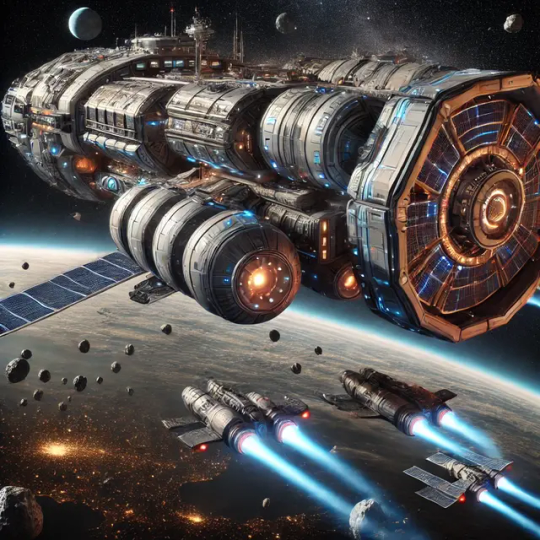
1. Ship Structure
Hull and Frame: A spaceship designed for deep space exploration needs a durable, lightweight frame. Advanced materials like titanium alloys and carbon-fiber composites would be used to ensure structural integrity under the stress of space travel while keeping the mass low. The outer hull would be made with multi-layered insulation to protect against micrometeorites and space radiation.
Dimensions: A cargo space vessel could be roughly 80-100 meters long and 30 meters wide, giving it sufficient space for cargo holds, living quarters, and propulsion systems.
Cost: $500 million (materials, assembly, and insulation).
2. Propulsion Systems
Primary Propulsion: Nuclear Thermal Propulsion (NTP) or Nuclear Electric Propulsion (NEP):
NTP would involve heating hydrogen with a nuclear reactor to achieve high exhaust velocities, providing faster travel times across the solar system. NEP converts nuclear energy into electricity, driving highly efficient ion thrusters. Both systems offer relatively efficient interplanetary travel.
A hybrid solution between NTP and NEP could optimize fuel efficiency for longer trips and maneuverability near celestial bodies.
Cost: $1 billion (development of nuclear propulsion, reactors, and installation).
Fuel: For NTP, hydrogen would be used as a propellant; for NEP, xenon or argon would be the ionized fuel. It would be replenished through in-space refueling depots or by mining water on asteroids and moons (future prospect).
Cost (fuel): $50 million.
3. Power Systems
Nuclear Fission Reactor: A compact fission reactor would power the ship’s life support, propulsion, and onboard systems. Reactors designed by NASA’s Kilopower project would provide consistent energy for long missions.
Backup Solar Arrays: Solar panels, optimized for efficiency beyond Mars’ orbit, would serve as secondary power sources in case of reactor failure.
Cost: $300 million (including reactors, solar panels, and energy storage systems).
4. Cargo Modules
The cargo holds need to be pressurized and temperature-controlled for sensitive materials or scientific samples, while some holds could be left unpressurized for bulk materials like metals, water, or fuel.
Modular Design: The ship should have detachable cargo pods for easy unloading and resupply at different planetary bodies or space stations.
Cost: $200 million (modular design, pressurization systems, automation).
5. Life Support Systems
Water and Oxygen Recycling: Systems like NASA’s Environmental Control and Life Support System (ECLSS) would recycle water, oxygen, and even waste. These systems are key for long-duration missions where resupply may be limited.
CO2 Scrubbers: To remove carbon dioxide from the air, maintaining breathable conditions for the crew.
Artificial Gravity (optional): A rotating section of the ship could generate artificial gravity through centripetal force, improving the crew’s health on longer missions. However, this would increase complexity and cost.
Cost: $200 million (life support systems, with optional artificial gravity setup).
6. AI and Automation
AI-Controlled Systems: AI would manage navigation, propulsion optimization, cargo handling, and even medical diagnostics. Automated drones could be used for ship maintenance and repairs in space.
Navigation: Advanced AI would assist in calculating complex orbital maneuvers, interplanetary transfers, and landings.
Autonomous Cargo Handling: Robotics and AI would ensure that cargo can be efficiently moved between space stations, planets, and the ship.
Cost: $150 million (AI development, robotics, automation).
7. Communication and Sensors
Communication Arrays: High-gain antennas would allow for deep-space communication back to Earth, supplemented by laser communication systems for high-speed data transfers.
Radars and Sensors: For mapping asteroid belts, detecting anomalies, and navigating planets, advanced LIDAR, radar, and spectrometers would be necessary. These sensors would aid in planetary exploration and mining operations.
Cost: $100 million (communication systems, sensors, and diagnostics).
8. Radiation Protection
Water Shielding: Water, which is also used in life support, would double as a radiation shield around the living quarters.
Electromagnetic Shields: Experimental concepts involve creating a small electromagnetic field around the ship to deflect solar and cosmic radiation (early TRL, requires more development).
Cost: $50 million (radiation shielding).
9. Crew Quarters
Living Quarters: Designed for long-duration missions with the capability to house 4-6 crew members comfortably. The quarters would feature radiation protection, artificial lighting cycles to simulate day and night, and recreational facilities to maintain crew morale on multi-year missions.
Medical Bay: An AI-assisted medical bay equipped with robotic surgery and telemedicine would ensure the crew remains healthy.
Cost: $100 million (crew quarters, recreational facilities, medical systems).
10. Landing and Exploration Modules
Surface Exploration Vehicles: For landing on moons or planets like Mars or Europa, a modular lander or rover system would be required. These vehicles would use methane/oxygen engines or electric propulsion to take off and land on various celestial bodies.
Cost: $300 million (lander, rovers, exploration modules).
---
Total Estimated Cost: $2.95 Billion
Additional Considerations:
1. Launch Vehicles: To get the spacecraft into orbit, you would need a heavy-lift rocket like SpaceX’s Starship or NASA’s Space Launch System (SLS). Multiple launches may be required to assemble the ship in orbit.
Cost (launch): $500 million (several launches).
2. In-Space Assembly: The ship would likely be built and assembled in low-Earth orbit (LEO), with components brought up in stages by heavy-lift rockets.
Cost: $200 million (orbital assembly infrastructure and operations).
---
Grand Total: $3.65 Billion
This estimate provides a general cost breakdown for building a cargo spaceship that could explore and transport materials across the solar system. This concept ship is realistic based on near-future technologies, leveraging both nuclear propulsion and automation to ensure efficient exploration and cargo transportation across the solar system.
#canada#canadian politics#space#science#scifi#scifiart#sci fi and fantasy#nasa#nasa photos#elon musk#share#engineering#ideas#ai#scientificresearch#billionaire
6 notes
·
View notes
Text
Dissertationposting 10: The Final Proof
IMPORTANT NOTE: I have not given enough credit in these posts. The first theorem about SYS manifolds is due to Schoen & Yau (1978), while the homological formulation of the proof is due to Schick (1998). The proof for M#X, X non-compact, is recent, and adapted from Chen (2024). The result for aspherical 3-manifolds was shown independently by Schoen & Yau and Gromov & Lawson (1980), although this proof is adapted from Chodosh & Li (2024). Gromov's various papers (some with Lawson) have loads of cool results with very different methods, but also are the worst formatted things I have ever seen.
Ok so this is nowhere near the final proof in the dissertation, but (shockingly) that was structured pretty differently. I'm just gonna go through all of the lemmas you need to prove that closed aspherical 3 manifolds are non-PSC. 4 & 5 are much more complicated, but without many new ideas. Depending on your background, you might get very different things out of this, and I'm not gonna hold back on the formalism here, it's all fairly important.
First off, the "thick" hypersurfaces.
Lemma 11.
Let M be a closed aspherical n-manifold with universal cover M̃. Then there exists a curve γ : R → M̃ such that for all L > 0, there is a compact hypersurface Σ with boundary such that d(∂Σ, γ) ≥ L and any (n−1)-chain α with boundary ∂α = k[∂Σ], k ≠ 0, meets γ.
Wow, what a ride. The picture is as follows. (Yes I know it looks phallic.)
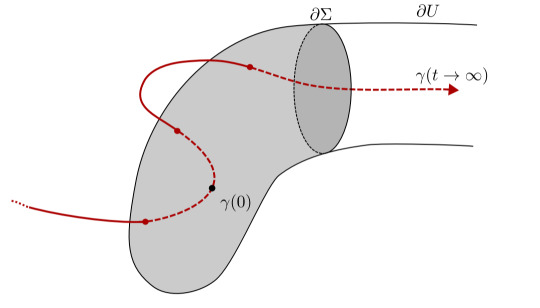
The idea is more or less as follows.
Find a "geodesic line" σ in M̃- that is, a distance preserving map R -> (M, g). [1] Note that the existence of σ uses the fact that M̃ is a universal cover, and is basically two applications of Arzela-Ascoli. [2]
Let U be the n-submanifold of points at most some distance L+ from σ[0,∞). Let Σ be the (n-1)-submanifold of ∂U of points at most some distance L0 from σ(0). Details in [3].
Perturb σ to a curve γ meeting everything transversely. Then the intersection fact comes from algebraic intersection number.
Do normal arguments to make sure that we can choose L+ and L0 arbitrarily large.
Great, a pretty standard metric space / differential topology argument. Now we get to skip the fiddly lemmas that you need I'm higher dimensions, and go straight to "thin" hypersurfaces. This should feel similar to the Laplacian-style arguments in earlier posts. Note that we'll apply this lemma to M̃, but I'll still call the ambient manifold M for notational reasons.
Lemma 12.
Let (M, g) be a complete Riemannian 3-manifold with R ≥ 2. Let Σ be a compact hypersurface with non-empty boundary, and φ > 0 a smooth function on Σ satisfying ∆φ + ½(2 - R_Σ)φ ≤ 0. Then for any p ∈ Σ, d(p, ∂Σ) ≤ 2π/√3.
Here d is the distance measured inside Σ, not M. Again, the rough steps aren't too bad. [4]
We want a Riemannian band, and the obvious choice is to pick some distance d, and let B be the points in Σ at most d away from the boundary. This doesn't quite work, so we take a warped product with S¹ by φ. Note that the condition on φ is cooked up to force the curvature of the warped band to be ≥ 2.
Again, we'll take h to be a scaled/shifted tan(distance). This time, the scaling and shifting makes 3/2 h² - 2 |∇h| ≥ 8π²/3d².
Take a μ-bubble Ω = Ω' × S¹. Taking 2π/√3 < d < √3π and f=1 in the μ-bubble lemma gives

But this is a contradiction by Gauss-Bonnet: ∂Ω = ∂Ω' × S¹ which cannot be a 2-sphere.
Basically, you have to repeat steps 1-3 once more for each additional dimension, except this makes the final contradiction harder and harder each time, because the curvature of the warped band is harder and harder to control.
Finally, we put it all together. If you wanna see how much harder this is for n=4, see [5].
Theorem 13.
A closed aspherical 3-manifold is non-PSC.
Suppose (M, g) is the universal cover of a closed aspherical Riemannian manifold with curvature R ≥ 2. Apply Lemma 11 with L + ε for some L > 0 to be fixed later and 0 < ε < L, to get a curve γ and compact hypersurface Σ_0 with boundary.
We can actually assume that Σ0 is stable minimal, as Lemma 11 only cares about homology class rel boundary, so we can minimise area like before.
Let Σ be the hypersurface obtained by removing a collar neighbourhood of ∂Σ_0 of radius ε.
We can apply Lemma 1 to Σ_0 and then restrict to Σ, to get a φ satisfying the Laplacian in Lemma 12. So taking L > 2π/√3 gives a contradiction.
And there we go! The final step you need for the classification of PSC 3-manifolds is the following, paralleling our earlier theorem.
Theorem 14.
If M is an aspherical manifold of dimension n ≤ 5, and X is closed, then M#X is non-PSC.
This is despite (unlike for SYS) M#X is not aspherical (the connecting sphere is homotopically non-trivial). I'll leave this as an exercise: the first step is to show that for any map f:N -> M there is a connected covering space N͆ and a proper lift f͆:N͆ -> M̃. The final step is to use local degrees and chains to get a contradiction in the style of 4. above.
Hope people have got something out of this! I've definitely been reminded how interesting this all is when you don't have to spend days checking all of your constants are right and your submanifolds are well-defined.
[1] Geodesic lines may not feel of much interest to the study of positive curvature, but they are in fact a weirdly powerful tool. For example, the Cheeger-Gromoll theorem shows that any complete connected Riemannian manifold with non-negative Ricci curvature splits isometrically as X × Rⁿ, where X has no geodesic lines.
[2] In full and brutal detail. This version of Arzela-Ascoli is the one in Bourbaki.
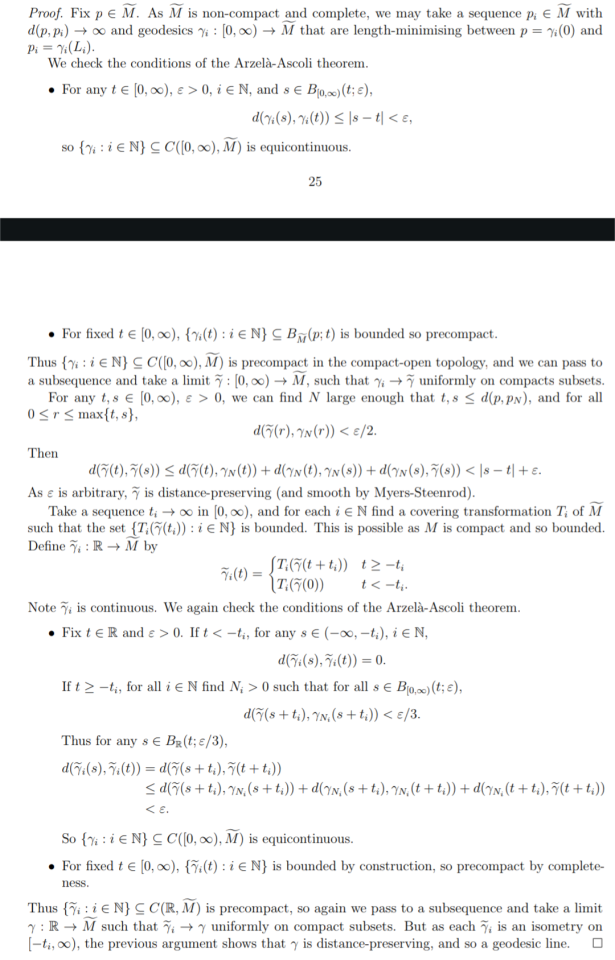
[3] The details here are mostly the approximations that come from smoothing.
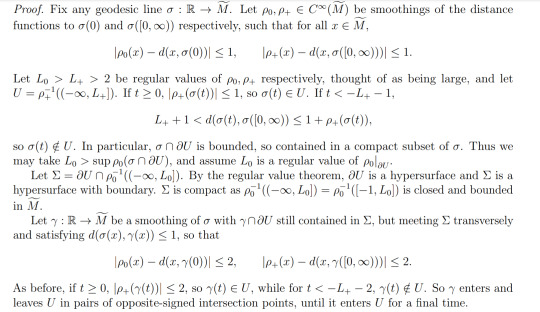
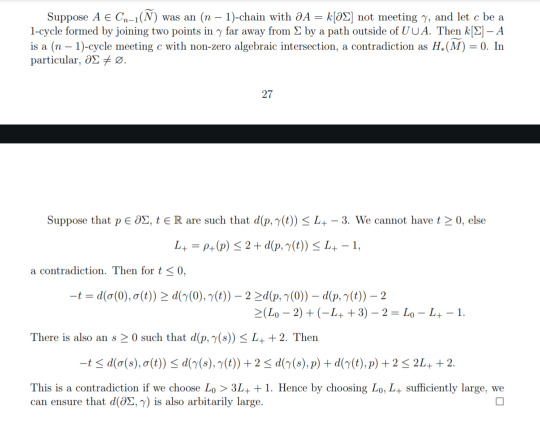
[4] Not much here beyond the details of h.

[5] First, the extra topological waffle.
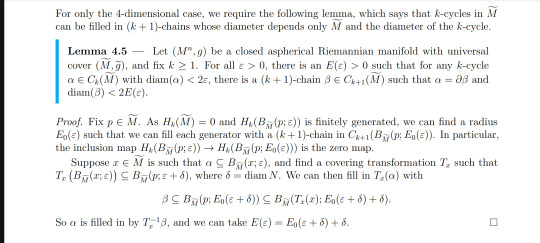
Then the statement+proof of Lemma 12.

Start the proof like for 3, but instead of (a) do this.
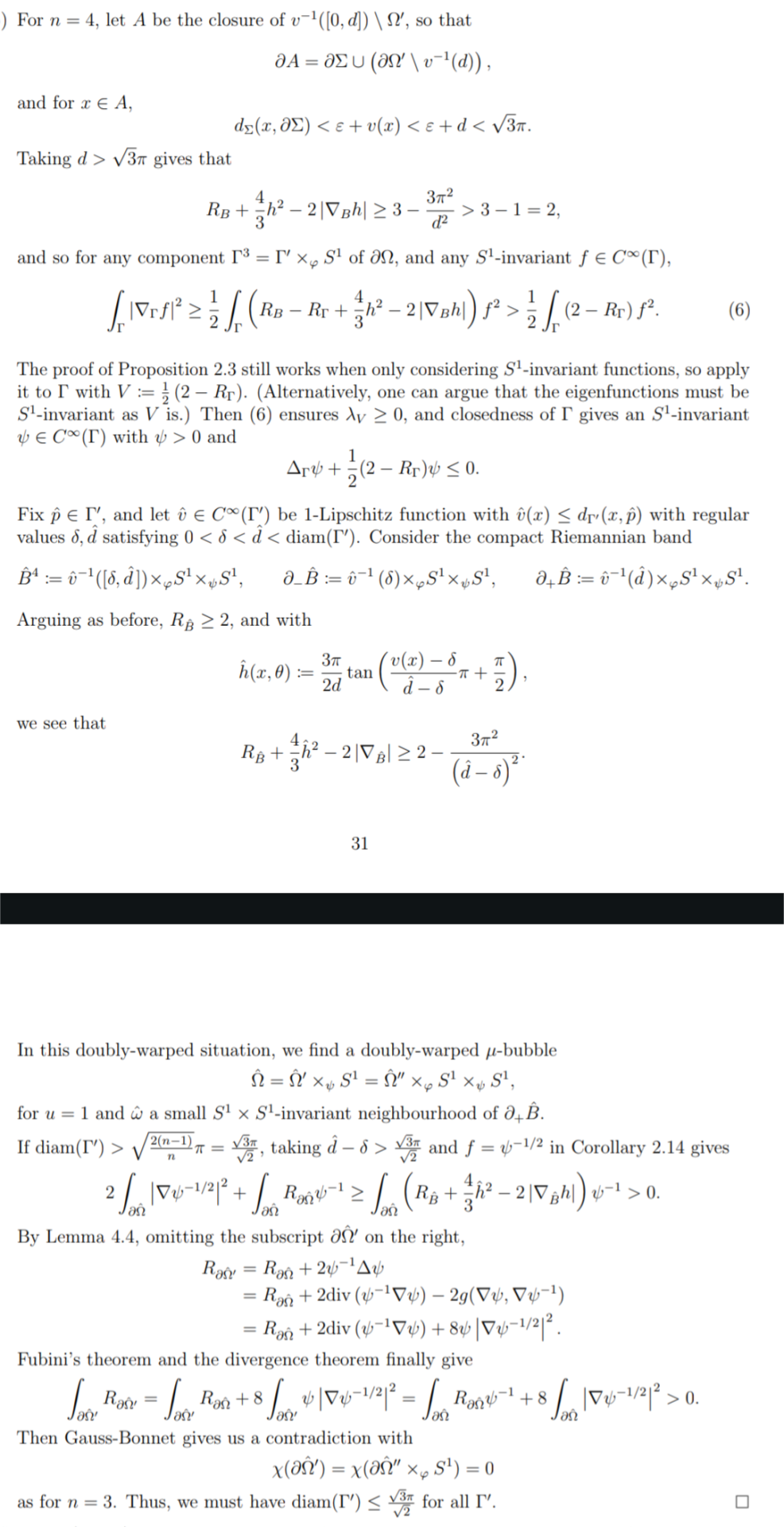
Finally, the putting it together. Again, start like 3, then:

Long.
5 notes
·
View notes